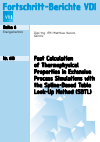Fast Calculation of Thermophysical Properties in Extensive Process Simulations with the Spline-Based Table Look-Up Method (SBTL)
Zusammenfassung
The presented Spline-Based Table Look-Up Method (SBTL) is intended to be used for fast and accurate property calculations in computationally extensive process simulations, such as Computational Fluid Dynamics (CFD), heat-cycle calculations, simulations of non-stationary processes, and real-time process optimizations, where conventional multiparameter equations of state may be unsuitable because of their computing time consumption. Through the use of the SBTL method, the results of existing property formulations are accurately reproduced at high computational speed. SBTL property functions, their first derivatives, and inverse functions are continuous and numerically consistent with each other. The developed algorithms are successfully applied in commercial and non-commercial software products for CFD, heat-cycle calculations, and simulations of non-stationary processes. The International Association for the Properties of Water and Steam has adopted the “Guideline on the Fast Calculat...
Schlagworte
- Kapitel Ausklappen | EinklappenSeiten
- I–XIV
- 1–3 1 Introduction 1–3
- 4–49 2 Property Calculation Algorithms for Numerical Process Simulations 4–49
- 2.1 Simple Thermal Equations of State
- 2.1.1 Ideal-Gas Model
- 2.1.2 Cubic Equations of State
- 2.2 Fundamental Equations of State
- 2.2.1 Reference Equations of State
- 2.2.2 Short Fundamental Equations of State for Industrial Applications
- 2.2.3 Fast Fundamental Equations for Separate Regions
- 2.3 Backward Equations
- 2.4 Table Look-Up Methods
- 2.4.1 One-Dimensional Functions
- 2.4.1.1 Local Polynomial Interpolation
- 2.4.1.2 Tabular Taylor Series Expansion Method (TTSE)
- 2.4.1.3 Spline Interpolation and Approximation Algorithms
- 2.4.2 Two-Dimensional Functions
- 2.4.2.1 Local Polynomial Interpolation
- 2.4.2.2 Tabular Taylor Series Expansion Method (TTSE)
- 2.4.2.3 Spline Interpolation and Approximation Algorithms
- 2.4.3 Thermodynamic Consistency of Table Look-up Methods
- 2.5 Computing Time
- 2.5.1 Computing Times of Various Operations
- 2.5.2 Computationally Efficient Implementation of Property Formulations
- 2.5.3 Computing-Time Comparisons
- 2.6 Conclusions for the Development of a Fast and Accurate Property Calculation Method for Extensive Process Simulations
- 50–70 3 The Spline-Based Table Look-Up Method (SBTL) 50–70
- 3.1 One-Dimensional Spline Functions
- 3.1.1 Spline Functions
- 3.1.2 Transformations
- 3.1.3 Inverse Spline Functions
- 3.1.4 Derivatives
- 3.2 Two-Dimensional Spline Functions
- 3.2.1 Spline Functions
- 3.2.2 Transformations
- 3.2.3 Inverse Spline Functions
- 3.2.4 Derivatives
- 3.2.5 Calculations in the Two-Phase Region
- 71–78 4 FluidSplines – Software for Generating SBTL Property Functions 71–78
- 4.1 Basic Structure
- 4.2 Generation of One-Dimensional SBTL Property Functions
- 4.3 Generation of Two-Dimensional SBTL Property Functions
- 79–94 5 SBTL Property Functions Based on IAPWS-IF97 for Water and Steam 79–94
- 5.1 Spline Functions of (v,u) and Inverse Functions
- 5.1.1 Range of Validity
- 5.1.2 Spline Functions for the Single-Phase Region
- 5.1.3 Calculations in the Two-Phase Region
- 5.1.4 Derivatives
- 5.1.5 Deviations from IAPWS-IF97
- 5.1.6 Numerical Consistency at Region Boundaries
- 5.2 Spline Functions of (p,h) and Inverse Functions
- 5.2.1 Range of Validity
- 5.2.2 Spline Functions for the Single-Phase Region
- 5.2.3 Calculations in the Two-Phase Region
- 5.2.4 Derivatives
- 5.2.5 Deviations from IAPWS-IF97
- 5.2.6 Numerical Consistency at Region Boundaries
- 5.3 Spline Functions for the Metastable-Vapor Region
- 5.3.1 Spline Functions of (v,u)
- 5.3.2 Spline Functions of (p,h)
- 5.3.3 Deviations from IAPWS-IF97
- 5.4 Computing-Time Comparisons
- 95–100 6 SBTL Property Functions Based on IAPWS-95 for Water and Steam 95–100
- 6.1 Spline Functions of (v,u)
- 6.1.1 Range of Validity
- 6.1.2 Spline Functions for the Single-Phase Region
- 6.1.3 Deviations from IAPWS-95
- 6.2 Spline Functions of (p,h)
- 6.2.1 Range of Validity
- 6.2.2 Spline Functions for the Single-Phase Region
- 6.2.3 Deviations from IAPWS-95
- 6.3 Computing-Time Comparisons
- 101–106 7 Bicubic Spline Functions for the Thermodynamic Potential s(v,u) for Water and Steam 101–106
- 7.1 Range of Validity
- 7.2 Property Calculations in the Single-Phase Region
- 7.3 Deviations from IAPWS-95
- 7.4 Computing-Time Comparisons
- 7.5 Property Calculations in the Two-Phase Region
- 107–113 8 Application of the SBTL Method in Computationally Expensive Process Simulations 107–113
- 8.1 Computational Fluid Dynamics
- 8.2 Heat Cycle Simulations
- 8.3 Nuclear Reactor System Safety Analysis
- 114–117 9 Summary and Outlook 114–117
- 118–152 Appendix 118–152
- A1 Grid Optimization Algorithm of Kretzschmar et al
- A2 Relationships between the Derivatives of the Residual Helmholtz Free Energy
- A3 Newton’s Method for Two Dimensions
- A4 Newton’s Method for Three Dimensions
- A5 Property Calculations in the Two-Phase Region from (p,h)
- A6 Property Calculations in the Two-Phase Region from (p,s)
- A7 Property Calculations in the Two-Phase Region from (h,s)
- A8 Property Calculations in the Two-Phase Region from (v,u)
- A9 Property Calculations in the Two-Phase Region from (p,v)
- A10 Property Calculations in the Two-Phase Region from (u,s)
- A11 Transformations and Grid Dimensions
- A12 Deviations of (v,u) and (p,h) Spline Functions from IAPWS-IF97
- A13 Deviations of (v,u) and (p,h) Spline Functions from IAPWS-95
- A14 Bicubic Spline Functions for s(v,u) and Derived Properties – Deviations from IAPWS-95
- 153–162 References 153–162


